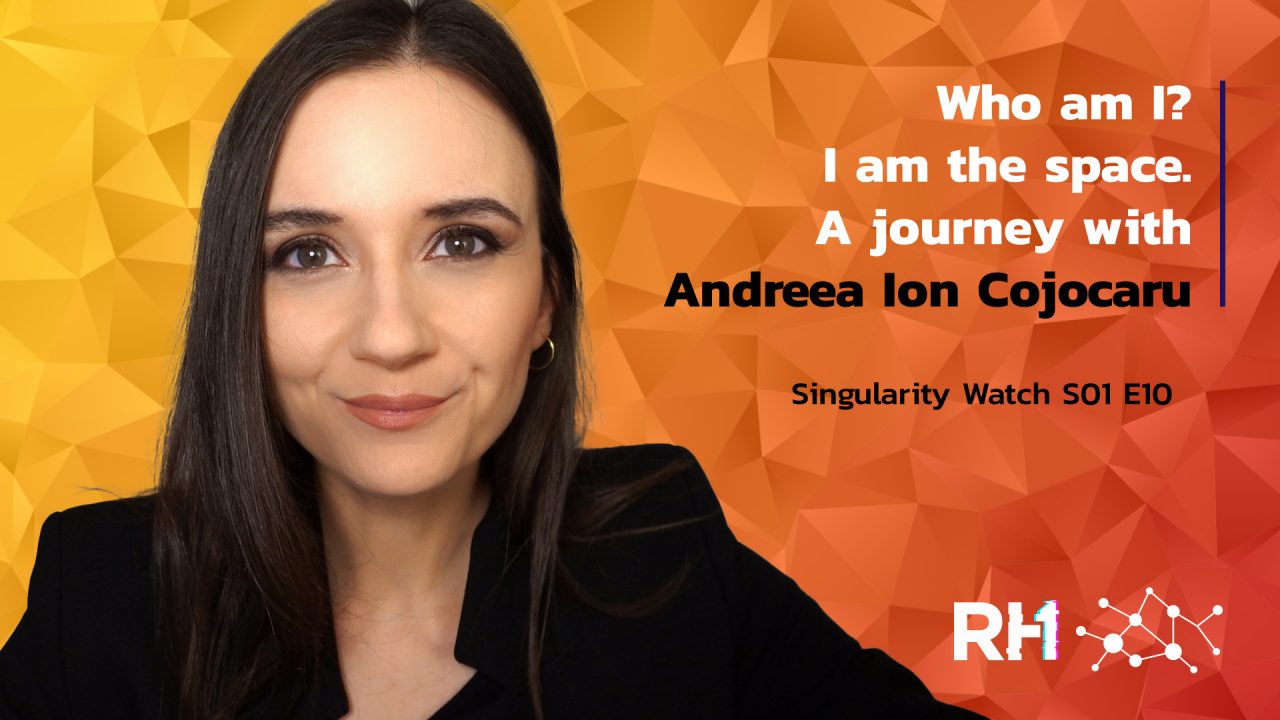Andreea is an architect.
Simple, right? Not at all.
In this ever-changing world, physical and virtual environments merge, and the concept of space evolves to a point where it changes the concept of being. We’re at a crossroads of disciplines, realities, and these interceptions can give birth to something completely new and to new directions. «I don’t know exactly which way it’s gonna go with architecture – says Andreea – I don’t know if what we call “virtual architecture” today is gonna end up splitting away from traditional architecture and becoming its own field of design, or if the entire field of architecture is going to go in this direction”.
Oli: Andreea, you’re an architect for both physical and virtual environments. Are they part of the same world someway?
AIC: Yes! For someone like me who is very interested in spatial experience, they are absolutely the same thing. Although you might get different answers from different architects. We’re living in such an interesting time where we have this intersection of these disciplines, and sometimes these interceptions are giving birth to something completely new and totally new directions, and sometimes they end up transforming existing areas of work and study. I actually don’t know exactly which way it’s gonna go with architecture. I don’t know if what we call “virtual architecture” today is gonna end up splitting away from traditional architecture and becoming its own field of design, or if the entire field of architecture is going to go in this direction and say “Hey, it’s not only physical buildings that are architecture with capital A, it’s also virtual office spaces and virtual living rooms and all of that”. So it’s an interesting crossroads that I’m seeing right now.
My personal desire is to actually see them addressed in a more holistic way: everything that has to do with spatial design, wheter there is a physical component or not, is architecture because that’s what an architect does, an architect designs spatial experience, whether that has as a goal the creation of an emotional state or it has a functional goal. The same kind of mechanism applies to both physical and virtual space.
O: You mentioned before that architecture, basically is all about space. And so is this something that is evolving in VR: when we imagine space in VR we kind of have an image of the 1990s, with these kinds of void spaces with fluorescent grids on them. That’s kind of the stereotype of space in VR and the other stereotype might be, for example, everything trying to imitate reality. Do you think there are other ways to kind of conceive space?
AIC: I’m hoping that imitating reality in virtual spaces it’s only an early phase that we’re going to overcome. Think of painting, for example: if we look at our history, we know that we went through a phase that was very representational, where we wanted to paint things that looked very much like the real object, and then it went through a lot of transformation. I’m not saying by any means that there’s anything wrong with accurate representation, it’s actually coming back right now, it’s trendy again 400 years later. But the thing that I’m hoping to see right now is more variety, like a lot of virtual environments, kind of look very similar, they have a similar approach to design, they kind of copy real spaces with something a little bit more extravagant, like you will see something floating in the air. But it’s just the tiny element, not the entire concept of the design. So I’m hoping to see this variety that we have in other art forms.
O: Do you already have some ideas?
AIC: A good indication of what might be coming, and I hope it’s coming, is the last chapter of Half-Life: Alyx. They are starting to play with the physical laws and there that this is the room you’re all of a sudden climbing the walls and things, they’re floating, and there’s this strange mirroring of the space happening. And all of a sudden, the design principle leaves behind anything that might be dictated by the laws of gravity and starting to do some kind of very strange things. A lot of architects that are working in VR right now, we are having a hard time breaking away from gravity because we have spent our entire education and professional life is completely trying to develop an instinct about how gravity is affecting design. All of a sudden, we’re in this virtual space and we recognize there’s no more gravity anymore. But then you find yourself being almost like a young student again because you need to develop a completely different kind of instinct. You have to throw away gravity out the window, your hard-earned instinct after 15 years of practice. And you need now an instinct for how to manipulate space in a different kind of way.
O: In a recent tweet, you mentioned that “VR is not storytelling. In a book or a script, it takes the entire thing to build up a world inside someone’s head. All to make them *feel*, towards the end, that they’re there, that something is happening. In VR, that’s the start. Do we know where to take the story from here?”. This leads me to two things. One is the last question, which I feel is really important. And the other is the whole concept of how VR affects our sense of agency and presence inside the virtual world. So, what’s your kind of the main emphasis when you wrote this, and what are your ideas about this?
AIC: That ended up actually being a bit controversial. I was taking some off today and it really upset some people. Some people say “are you saying VR cannot tell a story?” and of course I’m not saying that, of course, you can tell stories in VR. I was mainly dealing with storytelling as a discipline and a process that we have studied along years and years and that book authors and playwrights are studying. There are certain rules and certain tricks that you learn when you wanna become a playwright, for example, there are certain ways you build up an argument, and there are certain ways you build up a character and the strategies to introduce details about that character, and all of that is based on the fact that you cannot physically place the person there. You cannot physically have a person talk to that character, so you need all of these strategies to build that up.
In VR, there is no need for that anymore, we can place a person in a castle or on a beach so we don’t need one chapter of description off how golden the color of the sand is right, that becomes useless. So that for me fundamentally changes the rules of the game. What I thought was the rules of storytelling are just not that useful for me anymore. And the question then is “what are these new rules?” Like “What do we do if within a millisecond I’m having you on the sandy golden beach with the character and you see everything and you can experience everything?” Okay, then what?
O: My fear is that we’re kind of losing the ability to narrate our world, and that means the generation of people are kind of lost in with loads of tools, but nothing much to say. So I think that’s a big issue on a very deep kind of one that you as a philosopher is probably kind of the type of thing you cover, right?
So along those lines, there are two experiences that I feel are very interesting to discuss from this perspective. One is The book of distance and the other one is The collider. Basically, the book of distance is majestically well done, it’s a piece of VR where the designer kind of tells the story of his grandfather that was in a Japanese internment camp in Canada, and it’s just beautiful, and there’s some details in it that are totally brilliant. It is following a very linear path, and it is following very traditional rules and approach to storytelling. It’s a bit like an interactive exhibition, basically where you could be in an exhibition room and you would still have this person and maybe his father show up all of a sudden, a bit of realism and kind of guide you through that exhibition. For me, it was a reconstruction in VR extremely well done, and I wish it was not so linear. And I wished that my interaction with the story was not so inconsequential: the things that I was doing had absolutely no consequence on the narrative. And again, this is not the criticism of the thing, it’s one of the best VR pieces I have ever seen. I’m just addressing it from this point of view of what’s traditional storytelling and what might be new storytelling. And in contrast to that, there’s this experience called The Collider. It’s basically two people, one in VR and the one not in VR, and I the person who’s not in VR has your controllers, and it creates this very interesting psychological relationship and almost a bit of a power struggle depending on how you react to that, that brings out of you, very deep feelings and associations.
So, it’s not better by any means than the Book of Distance, but it has an element that’s a bit more new that could only be done in VR. And it’s also a new definition of what it means to tell a story. There was someone that commented on my tweet and said “Look, just make sure you have a story, and then you find the right way to say it”. Whereas if you look at the collider, it actually gives you a type of story that you could have never thought of without those tools. So you need VR to know that that kind of psychological involvement and narrative it’s possible.
Kavya Pearlman: You keep saying “cross-section” and “intersection”, and I feel that every single day because I’m thinking about cybersecurity, privacy and ethics, then there is the huge cross-section. It’s not like those things didn’t exist before, but we have to solve them for this extended reality, this portal that we opened within our space into another sort of dimension. If you were to say, What are your challenges, Andrea, As an architect?
AIC: That’s a great question. To put it bluntly, I feel a bit of an outsider in both areas, because architects are not crazy about VR in that they see it as the latest visualization tool. They do not necessarily see a conceptual potential in it. So, from the perspective of a lot of my architect friends, I’ve actually stepped down, I’m just using this new thing to visualize things and not engaged with ideas and with design, and then in the developer community and in the XR community, I’m also seeing sometimes by some people, not like everyone, of course, with some suspicion, because I’m an architect and my education is in architecture. So I feel pressure and somehow also a responsibility to stake an area for myself and for my work in between these two different fields. Maybe I’m not 100% of traditional architect anymore, and I’m not 100% of a coder, so I see myself somewhere in between, and I’m very comfortable in this space. Part of my work is to stake this space for myself and create the type of work that’s maybe good enough to prove itself to both of these two different camps, right, that there’s value into it. So it’s very challenging, it’s very difficult and sometimes stressful not to have a “tribe”, not to have your own discipline and your own conferences, where you feel 100% welcome and 100% at home. But it’s also, something very exciting at the end of the day.
KP: And also an opportunity. Perhaps you wanna be the one to pave the way for others and honestly when I look at your Twitter, I see leadership written all over it.
OD: I think in general it’s something that always comes with a degree of risk on a feeling that you know, I am I doing the right thing and I kind of just messing about and stuff like that. And then in the end, so there’s value in that and it comes out with, time and effort and stuff like that. And it’s also the way the world changes in a way, right? Because, um, you know the world doesn’t change because people do the same thing always.
KP: Exactly, especially our world is constantly evolving and changing. I’m gonna really hone in on one particular question that I was really, really looking forward to asking you, and that has something to do with privacy. So, as you know, Andreea, these new technologies, this technological evolution that is bringing different new risks, new opportunities, and so privacy, for example, in architecture refers to design choices that give people a sense of security and privacy in physical space. Is privacy something different in virtual spaces? How do we take that into account? How do we ensure privacy? And it’s a question that I’m struggling with as we work on this XRSI Privacy framework. There is the aspect of the data protection, and then there is this in-world privacy and especially, you know, when AR/VR converge, we’re talking about extending our reality into not just a completely immersed, but something that interacts with the reality. So what happens to privacy from your perspective? How do we build it?
AIC: I love to engage in this conversation with you because I feel like there’s an architect, a traditional architect, I can bring in that kind of perspective. In the physical world, everyone is pretty clear on what privacy means, right? We have surprisingly uniform approaches to that in architecture, even across cultures. So it doesn’t matter almost, almost, if you go to some city in the US or you go to somewhere in the Middle East, you still have the same kind of design requirements. So you don’t want people to look through your bathroom window, it’s like fog glass, or you don’t want people to necessarily have direct access to your kitchen table. And that is because I feel like the way people think and the way people’s bodies are pretty much the same, so we have similar, cross-cultural mental needs in that regard. When I tried, however, to apply exactly this kind of thinking and approach to virtual spaces, I discovered that it doesn’t fully work. Why doesn’t it work? Why can’t we say in virtual space, just like in physical space, people have the same needs, so you don’t want someone to come over your avatar, that’s uncomfortable, you might want to do something that no one is seeing for whatever reason, in some area? I can only give you the reason why it doesn’t work for me personally: it is because when I’m in the virtual space a lot of the things that are very clear in physical space are starting to dissolve. For example, embodiment: when I am in my own VR applications and test, I’m kind of testing design ideas all the time, I don’t like to be embodied in a humanoid form, so I prefer nonhumanoid forms, and I sometimes prefer to have to switch my views, like to have some kind of like an omnipresence, or I put cameras in different corners of the room and I switch like click, click, click, and I switch from different corners of the room. So not only am I not humanoid, but I’m having my sensory input and my powers and my relationship to space in being able in one click to see things from there and then see things from over there, it makes me feel sometimes like my whole body is the room, right? Like I am the room. I am the space. So you’re faced with this kind of feeling of “who am I” and what’s the extent of my space.
I’ve programmed my avatar in such a way that I really feel like this window is part of my virtual body, and I’ve really done that, and it’s kind of amazing.
So, if this is the kind of flexibility that we have about our body and the same kind of things also apply to identity, right, to who I am, then how do we deal with privacy? How do you offer privacy to someone who says, “I am this room”? Where do we even start? You have people in VR Chat that walk around dressed or in an avatar that’s a skyscraper, seven stories high. So, you say “Mr. Skyscraper, what are your privacy needs?” We should totally be asking that question, we should take into account the skyscrapers’ privacy needs. But you as a designer I feel like we need a framework that is more psychological in nature to start to know how to ask these questions. And it’s a completely different approach than a physical house and a physical kitchen and a physical toilet.
KP: So we’re towards the end of this episode and towards the end, as the name suggests, Singularity Watch, we started this show imagining the idea and understanding that a lot of these things are converging, are going towards perhaps, you know, some people call it “point of singularity”, and we want to be sort of the watcher of the space. What we do today impacts tomorrow. But, of course, there are different opinions. What, in your opinion, is this point of singularity? How close are we to where you know this sort of ultimate convergence takes place? And are we there yet or is it coming for us? And what should we do then?
AIC: This concept is mostly discussed in terms of AI and where that is going. But I would like to take a slightly different approach, and I would say for me the most interesting topic is not so much what’s happening with AI and if it’s gonna hit singularity or not, and when, but it’s what happens with us. How are we changing as we’re going through this journey? And if we do hit singularity I don’t care so much about the actual thing, whatever ends up being, whether it’s a robot, a program, or whatever. I actually care about what are we going to become, how it’s going to influence us. And I’m seeing so much potential for change in terms of these virtual worlds that have to do with having people question things that have never questioned before. So, I’ve never questioned the extent of my body before VR, I never thought I would come to say “I feel I’m a building”, I even questioned issues of gender identity, not in real life but in virtual space, do I feel like a woman or a man in here? Not really, I feel like this window, so what does it mean? Again, if someone had told me these things, a few years ago, I would have said “you’re hallucinating, I have no idea what you’re talking about”, and yet here I am discussing these things with you. So, for me, that’s such a profound change in what in philosophy is referred to as subjectivity. Normally these things are actually politically influenced like an entire government would make a program that sells you on being an American, or being an Italian, or being a German, and this is all too pushing people to a certain “how does it feel to be me”? I am American, I am a woman, I am this fixed identity that you’ve been placed into for political and socio-economic purposes, and yet we come in here and I’m like torn, I am maybe not American, not German, not Romanian, not a woman, maybe I’m this wall here, and that just turns everything upside down on a such a profound level. So, for me that singularity, finding out how far can we go down this road, questioning identity things we’ve never questioned before, what are we? Are we still human? What’s a human singularity? If we’re so flexible, and all these notions we’re actually impregnated on us from other things, and we have this amazing flexibility in our minds, when what are we? What are we in virtual spaces? What is our singularity? What is our convergent point? How far can we move? If I can get myself within 20 minutes to feel like I’m omnipresent in this room and can have eyes everywhere, so I would like in the future to have more discussion on this topic: what’s our singularity?
—
Stay tuned on Singularity Watch
Hosts
Oli D’Adda https://twitter.com/OliXRehab
Kavya Pearlman https://twitter.com/KavyaPearlman
Powered by XR Safety Initiative (XRSI)
www.xrsi.org | https://twitter.com/xrsidotorg
Ready Hacker One (RH1)
twitter.com/ReadyHackerOne
The Singularity Watch podcast is also available on:






